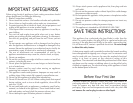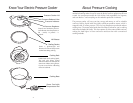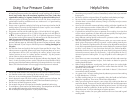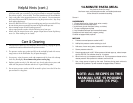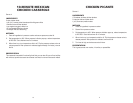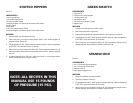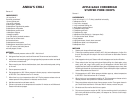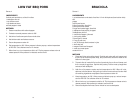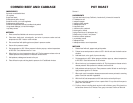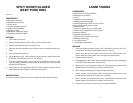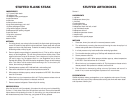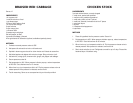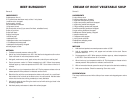
7
Helpful Hints
• Read this manual thoroughly and follow all recommendations.
• Start timing once pressure is reached. Immediately reduce heat to just maintain
that pressure.
• Be familiar with the recipe and have all ingredients ready before you begin.
• Be sure the lid is secured properly before developing pressure.
•Akitchen timer is a must-have accessory. Timing is a vital key to recipe success
when pressure cooking.
•You may wish to brown some meats before cooking with other ingredients. To
do so, preheat pressure cooker (without lid) to 350°. Add oil and brown meat.
Do not cover or develop pressure when browning.
• Cut foods into uniform-size pieces to promote even cooking. In recipes that
call for various ingredients, cut those that cook more quickly into larger pieces
and those that cook more slowly into smaller pieces.
• Many different cooking liquids can be used in a pressure cooker: wine, beer,
bouillon, fruit juices, water and more.
• After becoming familiar with your pressure cooker, you can convert conven-
tional recipes for pressure cooking. In general, reduce cooking times by two
thirds. The amount of liquid used may also have to be adjusted because there
is very little evaporation from the pressure cooker. Reduce the amount of liquid
so there is only about 1/2 cup more than desired in the finished product.
Remember, however, there must always be some liquid in the pressure cooker
to form the necessary steam. Try this formula ; 1 cup of liquid for the first 15
minutes of pressure cooking then 1/3 cup of liquid for each subsequent 15
minutes.
• Since flavors are more concentrated, reduce amounts of herbs and seasonings
when converting conventional recipes. Fresh herbs are better for pressure
cooking than dried herbs.
• When cooking dried beans, cereal grains, lentils, split peas, rice or other foods
that absorb liquid and expand, do not fill the cooker more than half full. The
normal fill line is two-thirds.
• Generally speaking, pressure cookers cook foods in about 1/3 the time of
conventional cooking methods.
• As a general rule, increase cooking times by about ten percent when cooking
in high altitudes over 3,500 feet.
• For faster cooking times on rice or vegetables, bring the liquid to a boil before
adding the ingredients. Then secure lid and lower temperature.
• When you are using frozen meats in your recipes, the cooking time does not
need to be altered. Pressure will not be acheived until the internal temperature
in the pot is 40 degrees higher than the boiling point of water. So if the recipe
declares the meat be cooked for 20 after pressure has been acheived, it will
still be the same. It will just take longer to come to pressure.
• Always check to make sure your gasket and float valve are clean and in good
working order.
6
Using Your Pressure Cooker
1. Gather all ingredients and be familiar with your recipe. Pour required amount
of liquid into pressure cooker, then add food. Use the cooking rack, if desired.
Never load cooker above the maximum ingredient level line. Foods that
expand while cooking (i.e. legumes) should never go above the halfway level.
2. Make sure gasket is securely positioned in the inner lid. Always examine the
gasket before installing and before each use. Make sure it is in good working
order and free of any tears.
3. Secure cover on pressure cooker by first lining up the arrows printed on the lid
and the cooker. Then twist the lid clockwise to secure in place (cover handles
should be directly above the body handles).
4. Plug power cord into unit first and then into a 120-volt 60 Hz AC only outlet.
5. Set the pressure regulator to 10 or 15 PSI by lining up the circle with
I
for 10
or
II
for 15. (Most recipes call for 15 PSI, or 15 pounds of pressure.) Turning
the regulator to the right increases PSI, and turning to the left decreases PSI.
Make sure pressure release valve is in the up position.
6. Set temperature dial to desired setting. Heat the pressure cooker until the
pressure indicator pops up, indicating high pressure has been achieved. Adjust
heat as indicated in your recipe to maintain pressure. Cooking time begins at
this point.
6. Set a kitchen timer and cook for the length of time specified in recipe. Then
reduce pressure as specified. When recipe states "let pressure drop on its own,"
turn temperature dial to OFF and unplug the cooker. When recipe states
"reduce pressure at once" or “reduce pressure manually”, flip the pressure
release valve to release steam and reduce pressure.
7. Pressure is completely reduced when the pressure indicator has dropped. Only
then is it safe to remove pressure cooker lid and serve food. Remove lid by
pressing green lid-release button and twisting lid counter-clockwise. As a safety
feature, the lid-release button will not engage unless all pressure is reduced.
Additional Safety Tips
• Always keep hands and face away from steam release valve when reducing pressure.
•Use extreme caution when removing lid after cooking. Always tilt the lid away
from you, so any remaining steam is blocked from your face.
• Never attempt to open lid while cooking, or before pressure indicator has
dropped. Do not attempt to defeat the safety lid-release button by forcing it.
• Do not cover or block the pressure valves.
• Do not touch the pot or lid except for the handles immediately after using.
•To avoid burns, allow food to cool before tasting. The temperature of the food
gets considerable hotter than with conventional cooking.
• Do not attempt to make applesauce in your pressure cooker.




